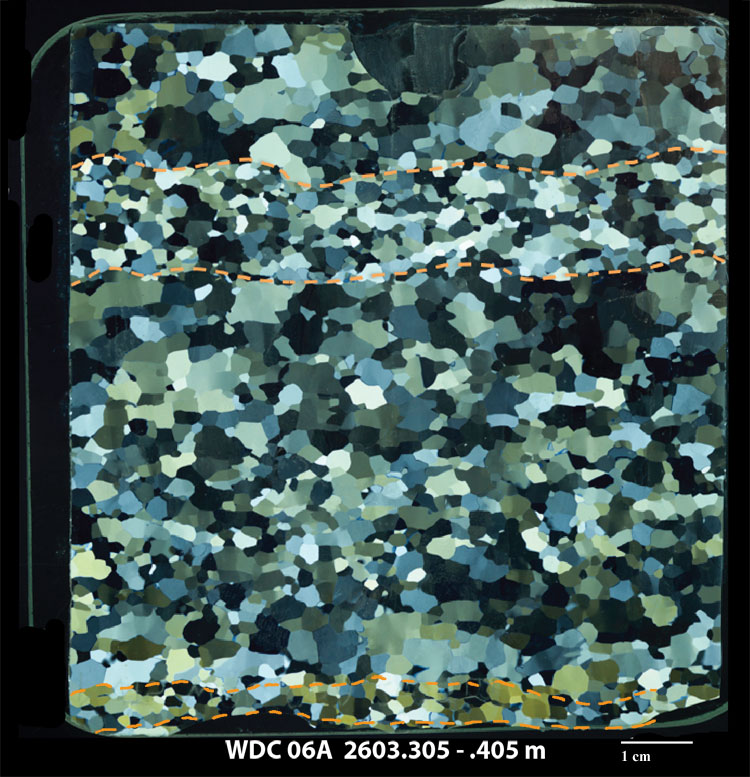News
Field and CPL Updates
2011 Core Processing Line

Seasonal grain-size contrast at WAIS Divide - possible clues to deformation processes
This image is a vertical thin section photograph of the WAIS Divide Core at 2603.305-.405 m depth in cross-polarized illumination. The approximate age of the ice is 21,000 years before present - during the Last Glacial Maximum. The different yellow, white, and gray regions are individual crystals, or grains. Grain size, shape and arrangement, and c-axis fabric, record the history of ice flow, and influence ongoing flow. Some of the physical-properties work seeks to understand the fundamental controls on these processes, so we can interpret the ice core better. And, sometimes this leads to surprises.
Dashed orange lines delineate layers of fine-grained ice (1-3 mm) surrounded by layers of coarser ice (2-7 mm). The lowermost fine-grained layer is cut off at the bottom of the section. The frequency of the paired coarse-grained / fine-grained layers in this and deeper samples is similar to the width of annual layers at this depth based on observations from visual stratigraphy and electrical data. Additionally, ECM/DEP shows no evidence that the fine-grained layers are associated with volcanic emissions. Taken together, these two observations suggest that the observed pairs are indeed annual layers.
What is unusual about the image is the occurrence of bimodal seasonal grain sizes at this depth, when samples from somewhat shallower indicate that processes in the ice have erased the grain-size differences seen in snow pits in the upper couple of meters. Existing grains grow over time, but also are split by processes associated with deformation, and new grains can nucleate. One hypothesis is that seasonal differences in impurity loading are shifting the recent balance between grain growth and nucleation or splitting as the ice deforms. Detailed comparison with continuous electrical and chemical measurements will help assess this hypothesis, as well as the possibility that the impurities in this ice are so different from younger samples that the seasonal grain-size contrasts have been preserved for more than 20,000 years since deposition.
Credit: Richard Alley (PSU), Joan Fitzpatrick (USGS), Isabel Hong (USGS), and Matt Spencer (LSSU).
Efficiency continues here at the National Ice Core Lab - we have worked through another 150 meters of ice, leaving a mere 500 meters left for this summer. We ended the week at a depth of 2830.4 meters. This is our second week in a row where we've progressed at a rate well beyond that required to reach the bottom of the core by August 19th. Hopefully this will buffer us in the case of any slowdowns in the coming weeks. Everyone seems excited by the progress and spirits remain high despite many here having been plugging away for six weeks.
Joan Fitzpatrick (USGS) gave a great introductory-level talk on Friday covering the physical properties of ice and why information from their studies is so critical for this ice core record. Physical properties work investigates the physical structure of the ice itself, from crystal orientation and size, to air-bubble numbers and densities. This data provides essential checks, which ensure that climate records derived from ice cores are not unduly altered by physical processes affecting the ice.
The physical property team recently noticed some interesting structures within the ice, and so has put together a science tidbit to keep everyone in the loop. Richard Alley (PSU), Joan Fitzpatrick (USGS), Isabel Hong (USGS), and Matt Spencer (LSSU) all contributed to this update.
We continue to plug away here! As always, thanks to everyone for helping with our continuing success.
Peter Neff
WAIS Divide SCO Representative, 2011 CPL

